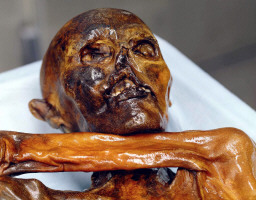
|
| ©Unknown |
Bolzano - The prehistoric mummy known as the Iceman was a shepherd and not a hunter, a new study from Germany claims.
Saarland University experts came to the conclusion after using mass spectrometry on what is left of the Iceman's clothes, conserved with his remains at a museum in this northern Italian city.
Using what they say are new methods, they found his shoes were made of cowhide and his clothes made of sheepskin.
The scientists, whose study has been published in the journal Rapid Communications in Mass Spectrometry, say this is conclusive proof that the Iceman was someone who drove herds of cattle or sheep.
Previous studies have supported this claim but others have argued he must have been a hunter because he was carrying a bow and arrow and parts of his shoes were made of deerskin.
The body, which dates back to 3000 BC, has spawned a global cottage industry of studies since he was found in a glacier in the Oetz mountain valley in 1991.
There have been discoveries about what he ate and what illnesses he suffered from, as well as a keen debate on how he died.
Two months ago Bristol University Space Technology Professor Mark Hempsell said he believed new evidence of an asteroid landing could be linked to the Iceman's death.
A newly deciphered Assyrian tablet describes the annihilation of communities near the Iceman's death site about the time he died, Hempsell said.
Hempsell advanced a second theory: that the Iceman, also known as Oetzi, may have been a powerful man who was the victim of a ritual sacrifice made to appease the mighty forces who sent the asteroid.
Ritual sacrifice had long been one of the favourite theories about the Iceman's death until a CAT scan in the late 1990s revealed an arrow wound in his body.
This led most experts to conclude he was shot during a fight with rival hunters.
Another study - fiercely contested by patriotic residents of this formerly Austrian region who see Oetzi as their proud forefather - reckons he was cast out from his community because a low sperm count rendered him childless.
Forensic science has made great strides since the Iceman was found by a couple of German hikers in 1991.
''We know so much about him, that he had blue eyes and a few diseases, was getting on a bit at 46, and died from an arrow wound,'' said Bolzano Archaeology Museum Director Angelika Fleckinger.
''But we will probably never know what really happened in the last hours and minutes of his life''.



Reader Comments
to our Newsletter